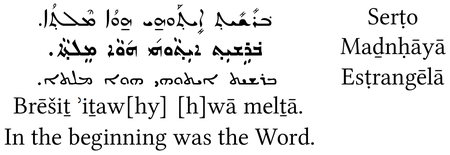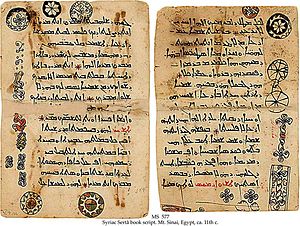Syriac alphabet
From Wikipedia, the free encyclopedia
| Syriac alphabet | |
 |
|
| Type | Abjad |
|---|---|
| Spoken languages | Syriac, Aramaic, Arabic (Garshuni) |
| Time period | ~200 B.C. to the present |
| Parent systems | |
| Child systems | Sogdian
→Orkhon (Turkic) |
| ISO 15924 | Syrc (Syriac) Syre (Esṭrangelā variant) Syrj (Western variant) Syrn (Eastern variant) |
| Note: This page may contain IPA phonetic symbols in Unicode. | |
- Note: This article contains special characters.
The Syriac alphabet is a writing system primarily used to write the Syriac language from around the 2nd century BC. It is one of the Semitic abjads directly descending from the Proto-Canaanite alphabet and shares similarities with the Phoenician, Aramaic, and Hebrew alphabets.
Contents |
[edit] General remarks
Syriac is written from right to left. It is a cursive script where some, but not all, letters connect within a word. The alphabet consists of 22 letters, all of which are consonants. The vowel sounds are supplied by the reader's memory or by pointing (a system of diacritical marks to indicate the correct reading).
In fact, three letters act as matres lectionis: rather than being a consonant, they indicate a vowel. ’Ālaph (ܐ), the first letter, represents a glottal stop, but it can also indicate a vowel at the beginning or the end of a word. The letter Waw (ܘ) is the consonant w, but can also represent the vowels o and u. Likewise, the letter Yōdh (ܝ) represents the consonant y, but it also stands for the vowels i and e.
In addition to the sounds of the language, the letters of the Syriac alphabet can be used to represent numbers in a system similar to Hebrew and Greek numerals.
[edit] Forms of the Syriac alphabet
There are three major variants of the Syriac alphabet. The oldest and classical form of the alphabet is Esṭrangelā (ܐܣܛܪܢܓܠܐ; the name is thought to derive from the Greek description στρογγύλη, strongylē, 'rounded'). Although Estrangelā is no longer used as the main script for writing Syriac, it has received some revival since the tenth century. It is often used in scholarly publications (for instance, the Leiden University version of the Peshitta), in titles and inscriptions. In some older manuscripts and inscriptions it is possible for any letter to join to the left, and older Aramaic letter forms (especially of Ḥeth and the lunate Mem) are found.
The West Syriac dialect is usually written in the Serṭā (ܣܪܛܐ 'line') form of the alphabet, also known as the Pšīṭā (ܦܫܝܛܐ 'simple'), 'Maronite', or the 'Jacobite' script (although the term Jacobite is considered derogatory). Most of the letters are clearly derived from Estrangelā, but are simplified, flowing lines. A cursive, chancery hand is evidenced in the earliest Syriac manuscripts, but important works were written in Estrangelā. From the eighth century, the simpler Sertā style came into fashion, perhaps because of its more economical use of parchment. The Nabataean alphabet (which gave rise to the Arabic alphabet) was based on this form of Syriac handwriting. The Western script is usually vowel-pointed with miniature Greek vowel letters above or below the letter which they follow:
- Α (capital alpha) represents a (ܦܬܚܐ, Pṯāḥā),
- α (lowercase alpha) represents ā (ܙܩܦܐ, Zqāp̄ā; pronounced as an o in the West Syriac dialect),
- ε (lowercase epsilon) represents both e and ē (ܪܒܨܐ, Rḇāṣā),
- H (capital eta) represents ī (ܚܒܨܐ, Ḥḇāṣā),
- and a combined symbol of Υ (capital upsilon) and ο (lowercase omicron) represents ū (ܥܨܨܐ, ‘Ṣāṣā).

The East Syriac dialect is usually written in the Madnḥāyā (ܡܕܢܚܝܐ 'Eastern') form of the alphabet. Other names for the script include Swādāyā (ܣܘܕܝܐ 'contemporary'), 'Assyrian' (not to be confused with the traditional name for the Hebrew alphabet), 'Chaldean', and, inaccurately, 'Nestorian', a term that was originally used to disparage Christians living in the Persian Empire. The Eastern script resembles Estrangelā more closely than the Western script, being somewhat a midway point between the two. The Eastern script uses a system of dots above or below letters, based on an older system, to indicate vowels:
- A dot above and a dot below a letter represent a (ܦܬܚܐ, Pṯāḥā),
- Two diagonally-placed dots above a letter represent ā (ܙܩܦܐ, Zqāp̄ā),
- Two horizontally-placed dots below a letter represent e (ܙܠܡܐ ܦܫܝܩܐ, Zlāmā pšīqā; often pronounced i in the East Syriac dialect),
- Two diagonally-placed dots below a letter represent ē (ܙܠܡܐ ܩܫܝܐ, Zlāmā qašyā),
- A letter Yōḏ with a dot beneath it represents ī (ܚܒܨܐ, Ḥḇāṣā),
- A letter Wāw with a dot below it represents ū or u (ܥܨܨܐ ܐܠܝܨܐ, ‘Ṣāṣā allīṣā),
- A letter Wāw with a dot above it represents ō or o (ܥܨܨܐ ܪܘܝܚܐ, ‘Ṣāṣā rwīḥā).
It is thought that the Eastern method for representing vowels influenced the development of the Niqqud markings used for writing Hebrew.
When Arabic began to be the dominant spoken language in the Fertile Crescent, texts were often written in Arabic with the Syriac script. These writings are usually called Karshuni or Garshuni (ܓܪܫܘܢܝ). Garshuni is often used by Assyrians and Chaldeans today in nonverbal communication such as in letters and fliers.
[edit] Short table
The Syriac alphabet consists of the following letters. Some letters have a different form used at the ends of words: these are shown in the table below the normal form. When isolated, the initial forms of the letters Kāp̄, Mīm, and Nūn are usually shown connected to their final form (see below).
Note that the table arranges the letters in order from left to right.
| ’Ālap̄ | Bēṯ | Gāmal | Dālaṯ | Hē | Wāw | Zayn | Ḥēṯ | Ṭēṯ | Yōḏ | Kāp̄ |
| ܐ | ܒ | ܓ | ܕ | ܗ | ܘ | ܙ | ܚ | ܛ | ܝ | ܟܟ |
| ܟ | ||||||||||
| Lāmaḏ | Mīm | Nūn | Semkaṯ | ‘Ē | Pē | Ṣāḏē | Qōp̄ | Rēš | Šīn | Taw |
| ܠ | ܡܡ | ܢܢ | ܣ | ܥ | ܦ | ܨ | ܩ | ܪ | ܫ | ܬ |
| ܡ | ܢ |
[edit] Letters of the Syriac alphabet
1 In the final position following Dālaṯ or Rēš, ’Ālap̄ takes the normal form rather than the final form.
[edit] Ligatures
[edit] Letter alterations
In modern usage, some alterations can be made to represent phonemes not present in classical orthography. A mark, called majliyana (similar in appearance to a tilde), is placed either above or below a letter in the Madnḥāyā variant of the alphabet to change its phonetic value (see also: Geresh):
- Added to Gāmal: [ɡ] to [dʒ]
- Added to Kāp̄: [k] to [tʃ]
- Added to Zayn: [z] to [ʒ]
- Added to Šīn: [ʃ] to [ʒ]
In addition to foreign sounds, a marking system is used to distinguish qūšāyā (ܩܘܫܝܐ, 'hard' letters) from rūkāxā (ܪܘܟܟܐ, 'soft' letters). The letters Bēṯ, Gāmal, Dālaṯ, Kāp̄, Pē, and Taw, all plosives ('hard'), are able to be spirantized into fricatives ('soft'):
| Name | Plosive | IPA | Spirant | IPA | Notes |
|---|---|---|---|---|---|
| Bēṯ | ܒ | [b] | ܒ݂ | [v] or [w] | The voiced labiodental fricative ([v]) is not found in most modern dialects. |
| Gāmal | ܓ | [ɡ] | ݂ܓ | [ɣ] | |
| Dālaṯ | ܕ | [d] | ݂ܕ | [ð] | |
| Kāp̄ | ܟܟ | [k] | ܟ݂ܟ | [x] | |
| Pē | ܦ | [p] | ܦ̮ or ݂ܦ | [f] or [w] | The voiceless labiodental fricative ([f]) is not found in most modern Eastern dialects. Instead, it appears as a labial-velar approximant ([w]) after vowels. Pē is the only letter in the Eastern variant of the alphabet that is spirantized by the addition of a semi-circle instead of a single dot. |
| Taw | ܬ | [t] | ݂ܬ | [θ] |
The degree to which letters can be spirantized varies from dialect to dialect as some dialects have lost the ability for certain letters to be spirantized. For native words, spirantization depends on the letter's position within a word (initial or final), location relative to other letters and vowels, and other factors. Foreign words do not follow the rules for spirantization.
[edit] Syriac in Unicode
|
|||||||||||||||||||||||
The Syriac Unicode range is U+0700 ... U+074F.
| 0 | 1 | 2 | 3 | 4 | 5 | 6 | 7 | 8 | 9 | A | B | C | D | E | F | ||
| 700 | ܀ | ܁ | ܂ | ܃ | ܄ | ܅ | ܆ | ܇ | ܈ | ܉ | ܊ | ܋ | ܌ | ܍ | | | |
| 710 | ܐ | ܑ | ܒ | ܓ | ܔ | ܕ | ܖ | ܗ | ܘ | ܙ | ܚ | ܛ | ܜ | ܝ | ܞ | ܟ | |
| 720 | ܠ | ܡ | ܢ | ܣ | ܤ | ܥ | ܦ | ܧ | ܨ | ܩ | ܪ | ܫ | ܬ | ܭ | ܮ | ܯ | |
| 730 | ܰ | ܱ | ܲ | ܳ | ܴ | ܵ | ܶ | ܷ | ܸ | ܹ | ܺ | ܻ | ܼ | ܽ | ܾ | ܿ | |
| 740 | ݀ | ݁ | ݂ | ݃ | ݄ | ݅ | ݆ | ݇ | ݈ | ݉ | ݊ | | | ݍ | ݎ | ݏ |
[edit] HTML code table
[edit] ’Ālap̄ Bēṯ
| ܕ | ܓ | ܒ | ܐ |
| ܕ | ܓ | ܒ | ܐ |
|---|---|---|---|
| ܚ | ܙ | ܘ | ܗ |
| ܚ | ܙ | ܘ | ܗ |
| ܠ | ܟܟ | ܝ | ܛ |
| ܠ | ܟ | ܝ | ܛ |
| ܥ | ܣ | ܢܢ | ܡܡ |
| ܥ | ܤ | ܢ | ܡ |
| ܪ | ܩ | ܨ | ܦ |
| ܪ | ܩ | ܨ | ܦ |
| ܬ | ܫ | ||
| ܬ | ܫ |
[edit] Vowels and unique characters
| ܲ | ܵ |
| ܲ | ܵ |
|---|---|
| ܸ | ܹ |
| ܸ | ܹ |
| ܼ | ܿ |
| ܼ | ܿ |
| ̈ | ̰ |
| ̈ | ̰ |
| ݁ | ݂ |
| ݁ | ݂ |
| ܀ | ܂ |
| ܀ | ܂ |
| ܄ | ݇ |
| ܄ | ݇ |
[edit] See also
- Abjad
- Alphabet
- Aramaic alphabet
- Aramaic language
- Mandaic language
- Syriac language
- History of the alphabet
- List of writing systems
| The Northwest Semitic abjad | |||||||||||||||||||||||||
|---|---|---|---|---|---|---|---|---|---|---|---|---|---|---|---|---|---|---|---|---|---|---|---|---|---|
| ʾ | b | g | d | h | w | z | ḥ | ṭ | y | k | l | m | n | s | ʿ | p | ṣ | q | r | š | t | ||||
| 1 | 2 | 3 | 4 | 5 | 6 | 7 | 8 | 9 | 10 | 20 | 30 | 40 | 50 | 60 | 70 | 80 | 90 | 100 | 200 | 300 | 400 | ||||
| history • Phoenician • Aramaic • Hebrew • Syriac • Arabic | |||||||||||||||||||||||||
[edit] External links
| Wikimedia Commons has media related to: Syriac |
|
|||||||||||






